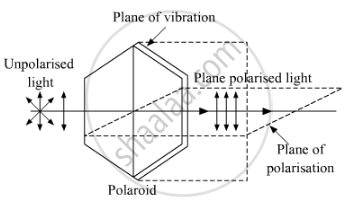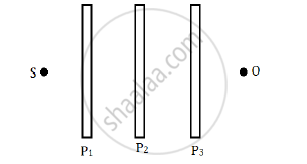Advertisements
Advertisements
प्रश्न
Why does an unpolarised light incident on a polaroid get linearly polarised ?
How does one get linearly polarised light with the help of a polaroid?
उत्तर १
When unpolarised light is passed through a polaroid crystal, only those vibrations of light pass through the crystal that are parallel to the axis of the crystal. All other vibrations will be absorbed by the crystal. In this way, the unpolarised light incident on a polaroid gets linearly polarised.

उत्तर २
We get linearly polarised light with the help of a polaroid as shown below:

The naked eye or the polariser cannot distinguish between unpolarised and plane polarised light. A crystal called analyser is used to analyse the nature of light.
If the axis of the polariser and the analyser are parallel to each other, the intensity of light is found to remain unaffected.
APPEARS IN
संबंधित प्रश्न
With the help of neat diagram, explain how non-polar dielectric material is polarised in external electric field of increasing intensity. Define polarisation in dielectrics.
Three identical polaroid sheets P1, P2 and P3 are oriented so that the pass axis of P2 and P3 are inclined at angles of 60° and 90° respectively with the pass axis of P1. A monochromatic source S of unpolarised light of intensity I0 is kept in front of the polaroid sheet P1 as shown in the figure. Determine the intensities of light as observed by the observer at O, when polaroid P3 is rotated with respect to P2 at angles θ = 30° and 60°.

Two polaroids P1 and P2 are placed with their pass axes perpendicular to each other. An unpolarised light of intensity Io is incident on P1. A third polaroid P3 is kept in between P1 and P2 such that its pass axis makes an angle of 45° with that of P1. Determine the intensity of light transmitted through P1, P2 and P3
Two polaroids P1 and P2 are placed with their pass axes perpendicular to each other. An unpolarised light of intensity I0 is incident on P1. A third polaroid P3 is kept in between P1 and P2 such that its pass axis makes an angle of 30° with that of P1. Determine the intensity of light transmitted through P1, P2 and P3
Two polaroids P1 and P2 are placed with their pass axes perpendicular to each other. Unpolarised light of intensity I0 is incident on P1. A third polaroid P3 is kept in between P1 and P2 such that its pass axis makes an angle of 60° with that of P1. Determine the intensity of light transmitted through P1, P2 and P3.
The refractive indices of glass and water w.r.t. air are 3/2 and 4/3 respectively. Determine the refractive index of glass w.r.t. water.
The glass plate of refractive index 1.732 is to be used as a polarizer, its polarising angle is _______.
What is unpolarised light?
An unpolarised light of intensity 32 Wm-2 passes through three Polaroids such that the axes of the first and the last Polaroids are at 90°. What is the angle between the axes of the first and middle Polaroids so that the emerging light has an intensity of only 3 Wm-2?
Can reflection result in plane polarised light if the light is incident on the interface from the side with higher refractive index?
